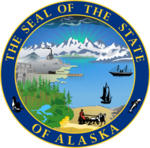Government of Alaska facts for kids

|
|
| Part of | United States of America |
|---|---|
| Constitution | Constitution of Alaska |
| Legislative branch | |
| Name | Legislature |
| Type | Bicameral |
| Meeting place | Alaska Capitol |
| Upper house | |
| Name | Senate |
| Presiding officer | Gary Stevens, President of the Senate |
| Lower house | |
| Name | House of Representatives |
| Presiding officer | Cathy Tilton, Speaker of the House |
| Executive branch | |
| Head of State and Government | |
| Title | Governor |
| Currently | Mike Dunleavy |
| Appointer | Election |
| Cabinet | |
| Leader | Governor |
| Deputy leader | Lieutenant Governor |
| Headquarters | State Capitol |
| Judicial branch | |
| Name | Judiciary of Alaska |
| Courts | Courts of Alaska |
| Alaska Supreme Court | |
| Chief judge | Daniel Winfree |
The government of Alaska works a lot like the United States government. It has three main parts, called branches, that each do different jobs. These branches are the executive, legislative, and judicial.
The executive branch is led by the Governor of Alaska. Its job is to carry out the laws. The legislative branch, also called the Legislature, makes the laws. It has two groups: the House of Representatives and the Senate. The judicial branch, or court system, makes sure laws are fair and handles legal cases.
Alaska also has many tribal governments. There are 246 of these groups that are recognized by the federal government. They help manage their own communities.
Contents
Executive Branch: Leading Alaska
The executive branch is in charge of making sure Alaska's laws are followed. The most important person in this branch is the Governor of Alaska. The Governor leads many state agencies that handle different parts of life in Alaska.
Some of the main state agencies include:
- Department of Administration (manages state offices)
- Department of Commerce, Community and Economic Development (helps businesses and towns)
- Department of Corrections (runs prisons)
- Department of Education and Early Development (oversees schools)
- Department of Environmental Conservation (protects the environment)
- Department of Fish and Game (manages wildlife)
- Department of Health and Social Services (helps with health and social needs)
- Department of Labor and Workforce Development (helps with jobs)
- Department of Law (provides legal advice)
- Department of Military and Veteran Affairs (supports military families and veterans)
- Department of Natural Resources (manages land and resources)
- Department of Public Safety (includes state troopers)
- Department of Revenue (collects taxes)
- Department of Transportation and Public Facilities (builds roads and airports)
Other important groups that are part of the executive branch are:
- Alaska Division of Juvenile Justice (helps young people in trouble)
- Alaska Permanent Fund (manages Alaska's oil money)
- Alaska Volcano Observatory (watches volcanoes)
- Alaska Oil and Gas Conservation Commission (oversees oil and gas)
- Alaska State Pension Investment Board (manages state retirement funds)
Currently, the Governor of Alaska is Mike Dunleavy. The Lieutenant Governor is Nancy Dahlstrom.
Legislature: Making Laws for Alaska
Alaska has a Legislature that creates the state's laws. It is a bicameral system, which means it has two parts or "chambers."
The first part is the Alaska House of Representatives. It has 40 members. The second part is the Alaska Senate, with 20 members. Each member represents a different area of Alaska. The Legislature meets in the State Capitol building, which is in Juneau.
Judiciary: Alaska's Court System
The Alaska Court System is the state's court system. It is managed from one central place and funded by the state. This system makes sure that laws are fair and that justice is served.
There are different types of courts:
- The Alaska District Courts handle smaller legal issues, like misdemeanor crimes.
- The Alaska Superior Courts deal with more serious crimes, called felony cases.
- The Alaska Supreme Court and the Alaska Court of Appeals are the highest courts. They review decisions made by the lower courts.
The Chief Justice of the Alaska Supreme Court is the main leader of the entire Alaska Court System.
Local Government: Communities in Alaska
Alaska has two main types of local governments: boroughs and cities.
- There are 19 boroughs in Alaska. They are similar to counties in other states.
- There are also 144 cities.
Because Alaska has a low population in many areas, a large part of the state is called the Unorganized Borough. This area does not have its own local borough government. Instead, the state government manages services there directly.
Some cities, like Anchorage and Juneau, have combined their city and borough governments. This makes it simpler to provide services to everyone in those areas. Other places have separate city and borough governments. Borough governments usually serve less crowded areas than city governments.
Alaska has different levels of boroughs and cities, like "home rule," "first class," and "second class." These levels mean they have different responsibilities and powers. For example, "home rule" governments can often do more things and collect more taxes than "second class" governments. They might have more control over schools, land use, or transportation.
In areas of the "Unorganized Borough," the state government provides most services. These are services that cities or boroughs would normally offer.
See also
- Politics of Alaska
- Impeachment in Alaska

